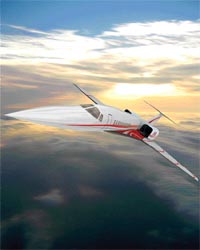When not one but two supersonic business jet (SSBJ) projects broke the news barrier at NBAA last October, the industry's established manufacturers were conspicuous in their absence from either team.
Since springing their surprises on the business aviation world gathered in Las Vegas, unknowns Aerion and Supersonic Aerospace International have adopted a low profile. But Aerion will be providing an update today on both its market prospects and changes to the design of its supersonic concept.(see separate story)
The US industry, meanwhile, has been hard at work behind the scenes trying to persuade NASA to fund an X-plane programme to flight-demonstrate the low sonic boom technology it believes is essential for any future supersonic aircraft, be it a long-range bomber, a commercial transport or a business jet.
The task has been made more difficult by the deep cuts in aeronautics research funding in NASA's fiscal 2006 budget, but a plan to build and fly a sub-scale low-boom demonstrator remains intact - for now.
Overpressure
Encouraged by the success of the Shaped Sonic Boom Demonstrator (SSBD) - a modified Northrop F-5 that proved airframe shaping can reduce the sonic-boom overpressure - US airframe and engine manufacturers came together in July last year to form the Supersonic Cruise Industry Alliance. The group comprises Boeing, Cessna, Gulfstream, Lockheed Martin, Northrop Grumman and Raytheon, as well as General Electric, Pratt & Whitney and Rolls-Royce's Allison Advanced Development unit. The 10th member is business-jet fractional ownership company NetJets.
Engine-maker Rolls-Royce, whose Olympus engines on Concorde clocked up more supersonic hours than all the world's military forces, believes it can be done. The Anglo-American company has worked with both Lockheed Martin and Gulfstream. "We completed engine studies earlier this year looking at a relatively high bypass and something more like Concorde," says Ric Parker, Rolls-Royce director of research and technology. "We have something like $2 billion worth of database from our experience with Concorde so we would hope to be part of something going forward."
The alliance's charter is to "enable quiet, safe, affordable, environmentally safe supersonic flight over land within 10 years", says Eric Brachhausen, vice-president of American Technology Alliances (AmTech). The industry group is working with NASA, the US Federal Aviation Administration and Department of Defense under the Super 10 Alliance, assisted by AmTech - a non-profit organisation engaged to facilitate collaboration by the industry consortium and the larger alliance.
Brachhausen says the industry alliance made a preliminary presentation to NASA in October last year, leading to a detailed proposal for a flight demonstrator programme being presented in December. Industry proposed a stepping-stone approach, he says, starting small but eventually leading to integration of the multiple technologies required for quiet supersonic flight, including sonic-boom mitigation, propulsion integration, aerodynamics, structures and systems.
But there was a hitch: there was no way NASA could afford the $1 billion pricetag on the industry's proposed programme. The agency asked the alliance to rescope the project, Brachhausen says, focusing it on a breakthrough consistent with NASA's desire "to produce outcomes not output".
Proposal
By January, the industry group had put together a proposal for a small-scale low boom demonstrator, and the quiet supersonic project was one of only four to make it into NASA's FY2006 request in February.
The industry team is about to begin a NASA-funded concept exploration study to flesh out a more modest, $150 million programme to fly a small manned X-plane that would demonstrate sonic boom can be reduced by shaping the entire airframe, not just the forward fuselage as was the case with the F-5 SSBD.
This would be a major step toward the development of a quiet SSBJ, as regulators must be convinced that sonic boom can be reduced to a publicly acceptable level before they will lift the ban on supersonic flight over land.
The FAA is beginning to look at the issue under the Super 10 Alliance, and Brachhausen says the issue of quiet supersonic flight was discussed for the first time at a recent meeting of CAEP, the International Civil Aviation Organisation's environmental committee.
"They are beginning to think through the issues," he says.
Source: Flight Daily News























